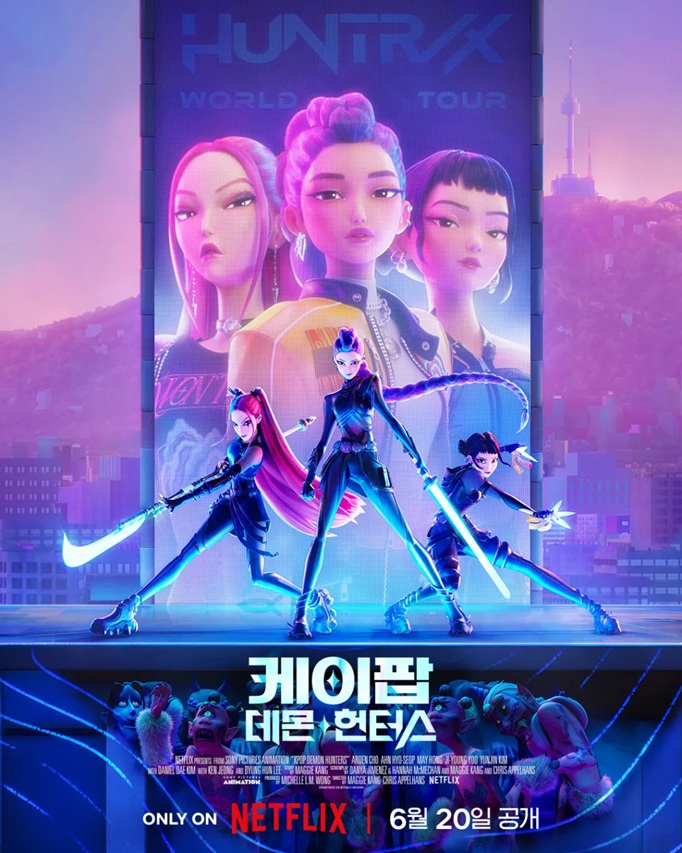🤔 What is KPop Demon Hunters?
KPop Demon Hunters represents a groundbreaking fusion of Korean pop culture, supernatural storytelling, and cutting-edge animation that has captivated audiences worldwide since its debut. This innovative animated musical series combines the infectious energy of K-pop with the rich mythology of Korean folklore, creating an entirely new genre that bridges Eastern and Western entertainment sensibilities.
🎬 The Revolutionary Concept
At its core, KPop Demon Hunters is an animated musical adventure that follows the extraordinary journey of Huntr/x (헌터/엑스), a three-member K-pop girl group who discover they are destined to become supernatural warriors tasked with protecting humanity from demonic forces. This isn't just another animated series with musical numbers – it's a meticulously crafted narrative that uses music as both storytelling device and emotional catalyst, where every song serves a specific purpose in advancing the plot and developing character arcs.
The series masterfully blends multiple genres: it's simultaneously a coming-of-age story, a supernatural thriller, a musical spectacular, and a cultural bridge between Korean traditions and global pop culture. Each episode seamlessly weaves together high-energy musical performances with intense action sequences, emotional character development, and stunning visual artistry that pushes the boundaries of what animated entertainment can achieve.
🌍 Cultural Significance and Global Impact
What sets KPop Demon Hunters apart from other animated series is its authentic representation of Korean culture while maintaining universal appeal. The creators have invested considerable effort in researching and incorporating genuine elements of Korean mythology, particularly the concept of Saja (사자) – traditional death gods or reapers from Korean folklore – and reimagining them as modern antagonists who have infiltrated the entertainment industry.
The series doesn't merely use Korean culture as window dressing; it deeply explores themes of identity, heritage, and the struggle between tradition and modernity that many Korean-Americans and global K-pop fans experience. Through Rumi's half-demon heritage and Zoey's Korean-American background, the show addresses complex issues of cultural identity, belonging, and the pressure to bridge different worlds – themes that resonate far beyond its target demographic.
The global impact has been unprecedented. Within months of its release, KPop Demon Hunters sparked a new wave of interest in Korean mythology among international audiences, led to collaborations between Korean and Western artists, and inspired countless fan creations, cosplay communities, and academic discussions about cross-cultural storytelling in animation.
🎵 Musical Innovation and Artistic Excellence
The musical component of KPop Demon Hunters represents a revolutionary approach to animated storytelling. Unlike traditional musicals where songs often feel inserted into the narrative, every musical number in the series serves multiple functions: advancing the plot, revealing character motivations, providing exposition, and creating emotional resonance with the audience.
The soundtrack features an impressive roster of both established and emerging artists, including E-jae, Audrey Nuna, and REI AMI as the voices of the main trio, alongside contributions from renowned producers like TEDDY, 24, and IDO. Each song is crafted to reflect both the character singing it and the specific moment in their journey, creating a cohesive musical narrative that stands alone as an album while serving the larger story.
The animation style itself is a visual feast that combines traditional 2D animation techniques with cutting-edge 3D elements, creating a unique aesthetic that feels both timeless and thoroughly modern. The character designs draw inspiration from both K-pop fashion trends and traditional Korean art, while the demon designs incorporate elements from classical Korean paintings and sculptures, creating a visual language that is distinctly Korean yet universally appealing.
👹 The Mythology and World-Building
The world of KPop Demon Hunters is built upon a rich foundation of Korean supernatural beliefs, particularly the concept that demons and spirits exist alongside humans in the modern world. The series posits that these supernatural entities have evolved with human society, adapting to contemporary forms and infiltrating modern institutions – particularly the entertainment industry, where they can influence large numbers of people simultaneously.
The Saja Boys, the primary antagonists, represent this evolution perfectly. They appear as a charming, irresistible K-pop boy band that captures the hearts of fans worldwide, but their true nature as soul-draining demons reflects contemporary anxieties about parasocial relationships, fan culture, and the potentially destructive power of celebrity worship. This clever metaphor allows the series to explore serious themes about media consumption, identity, and the price of fame while maintaining its entertaining, action-packed surface.
The demon-hunting tradition itself is portrayed as an ancient lineage that has been protecting humanity for generations, with each era requiring new approaches and new warriors. The Sain-gum sword that Rumi wields is not just a weapon but a symbol of this continuity – a bridge between ancient traditions and modern necessities.
⚔️ The Sain-gum - Rumi's Legendary Sword

The Sain-gum is an ancient demon-slaying sword passed down through generations of demon hunters. Only those with demon blood can wield its full power, making Rumi the perfect warrior to carry on the legacy.
🐯 The Tiger and Magpie in Korean Traditional Culture
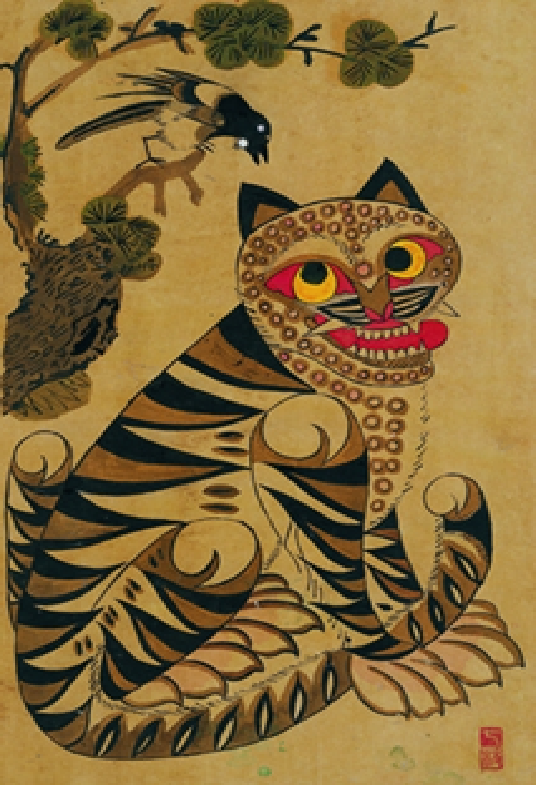
The series draws significant inspiration from traditional Korean folk paintings known as Minhwa, particularly the iconic "Tiger and Magpie" (호작도, Hojakdo) paintings. In Korean folklore, tigers represent both fearsome power and protection against evil spirits, while magpies symbolize good fortune and joyful news.
In the show, this symbolism is cleverly reimagined through Mira's fighting style, which embodies the tiger's strength and agility, while Zoey's technological innovations and communication skills reflect the magpie's intelligence and role as a messenger. The contrast between fear and hope represented in these traditional paintings directly parallels the show's central theme of finding harmony between opposing forces.
Episode 5, "The Tiger's Smile," explicitly references this tradition when the team discovers ancient scrolls depicting demon hunters throughout history, always accompanied by tiger and magpie imagery as protective symbols. This cultural touchstone provides both aesthetic inspiration for the show's visual design and deeper thematic resonance with Korean artistic heritage.
🎨 Technical and Artistic Achievements
From a technical standpoint, KPop Demon Hunters represents a significant achievement in animated entertainment. The series employs a hybrid animation style that seamlessly blends 2D character animation with 3D environments and effects, creating a visual experience that feels both intimate and epic. The fight choreography is particularly noteworthy, incorporating elements of traditional Korean martial arts, modern dance, and supernatural abilities in ways that feel both authentic and fantastical.
The sound design extends far beyond the musical numbers, creating an immersive audio landscape that includes traditional Korean instruments alongside modern electronic elements. The voice acting, available in both Korean and English, maintains authenticity while ensuring accessibility for global audiences. The Korean terms and concepts are naturally integrated into the dialogue, educating viewers about Korean culture without feeling forced or didactic.
🎆 Cultural Bridge and Future Implications
Perhaps most importantly, KPop Demon Hunters serves as a cultural bridge, introducing global audiences to Korean mythology, values, and storytelling traditions while presenting them in a format that feels familiar and accessible. The series demonstrates that animated content can be both entertaining and educational, commercial and artistic, traditional and innovative.
The success of KPop Demon Hunters has opened doors for more cross-cultural animated projects and has proven that audiences are hungry for diverse stories told with authenticity and respect. It has inspired other creators to explore their own cultural mythologies and has shown that global audiences are ready for content that doesn't conform to Western storytelling conventions.
As the series continues to evolve, it represents not just entertainment but a new model for how animated content can serve as cultural ambassador, artistic expression, and commercial success simultaneously. KPop Demon Hunters is more than just a show – it's a cultural phenomenon that has redefined what animated musical entertainment can be and has set a new standard for cross-cultural storytelling in the digital age.
With its perfect blend of action, music, mythology, and heart, KPop Demon Hunters stands as a testament to the power of animation to transcend cultural boundaries while celebrating the unique elements that make each culture special. It's a series that honors its Korean roots while embracing its global audience, creating something entirely new in the process.
🎭 Main Characters
Huntr/x (헌터/엑스) - The demon-hunting K-pop girl group at the center of the story:

Rumi (Credit: Netflix)
Voice: E-jae / Kim Do-yeon (vocals)
The leader and main vocalist with half-demon heritage that gives her unique powers. Her internal struggle between her human and demon sides drives much of the narrative.
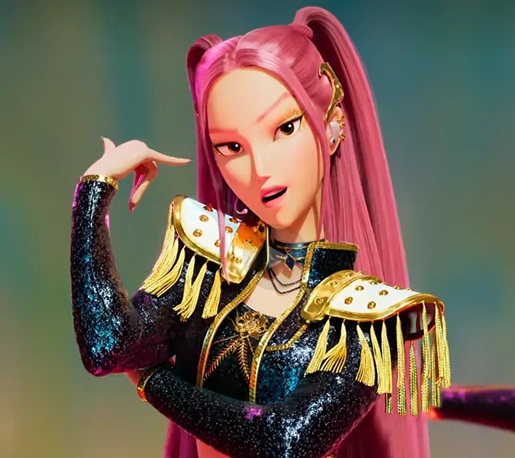
Mira (Credit: Netflix)
Voice: Audrey Nuna / Park Hye-su (vocals)
The main dancer and sub-vocalist, skilled in ancient Korean martial arts. Her fierce determination and loyalty make her the group's warrior spirit.
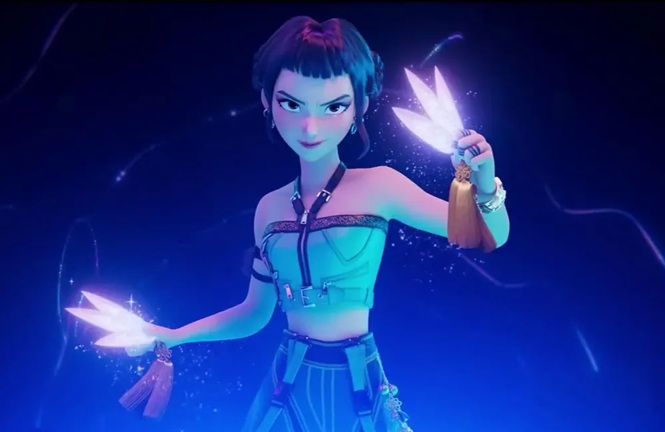
Zoey (Credit: Netflix)
Voice: Rei Ami / Yoo Ji-young (vocals)
The rapper and maknae, Korean-American from Burbank with exceptional tech skills. Her cultural bridge between East and West adds depth to the group dynamic.
😈 The Saja Boys - From Idols to Demons
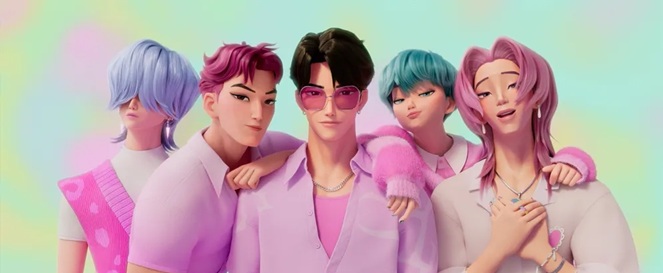
The Saja Boys as K-pop Idols (Credit: Netflix)
The charming boy band that captivates fans worldwide
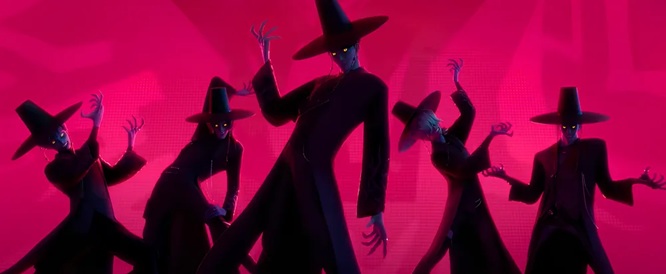
Their True Demon Form (Credit: Netflix)
The terrifying reality behind their perfect facade
The antagonist demon boy band led by Jinu (Ahn Hyo-seop), designed to drain human souls through fan obsession. They use their irresistible charm and hypnotic music to capture the essence of their devoted fans.
Supporting Cast:
- Celine (Kim Yunjin, singing: Lea Salonga) - Rumi's foster mother and former demon hunter
- Healer Han (Daniel Dae Kim) and Manager Bobby (Ken Jeong) - Comic relief and guardians
🎵 Complete Soundtrack Analysis
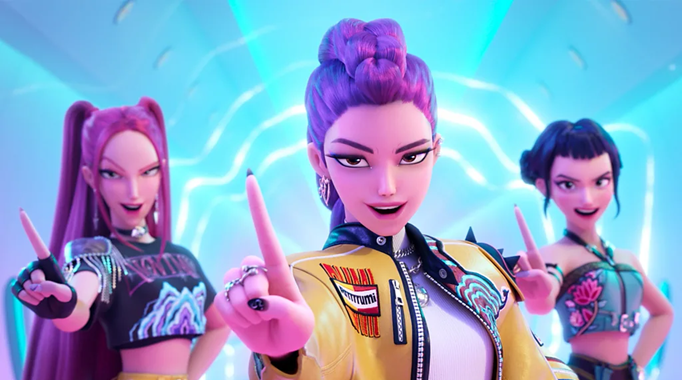
(Credit: Netflix)
1. How It's Done
Performed by: EJAE (Rumi), Audrey Nuna (Mira), REI AMI (Zoey)
Writers: EJAE, Mark Sonnenblick, Danny Chung | Producers: 24, IDO, TEDDY, Ian Eisendrath
This energetic opener introduces the heroines battling demons and entering the limelight.
"We're gonna show 'em how it's done / Step into the light, it's our fight…"
Huntrix - "How It's Done" Official Music Video | KPop Demon Hunters
2. Golden
Performed by: EJAE, Audrey Nuna, REI AMI
Writers: EJAE, Mark Sonnenblick | Producers: IDO, 24, TEDDY, Ian Eisendrath
A motivational "I-want" anthem with an emotional bridge as Rumi battles her identity.
"We're goin' up, up, up / It's our moment… it's golden"
HUNTR/X (Huntrix) - "Golden" Music Video | KPop Demon Hunters
3. Soda Pop (by Saja Boys)
Performed by: Andrew Choi, Neckwav, Danny Chung, Kevin Woo, samUIL Lee
Writers: Vince, KUSH, Danny Chung | Producers: 24, DOMINSUK, Ian Eisendrath
Bubblegum contrasts sinister intent to consume souls.
"You taste just like soda pop / So sweet, gonna drink you up…"
KPop Demon Hunters - "Soda Pop" by Saja Boys
4. Takedown – Huntr/x version
Performed by: EJAE, Audrey Nuna, REI AMI
Writers/Producers: Lindgren, Ian Eisendrath
Warrior anthem full of aggression and identity conflict.
HUNTR/X - "Takedown" Official Music Video | KPop Demon Hunters
5. Takedown – TWICE version (end credits)
Performed by Jeongyeon, Jihyo & Chaeyoung from TWICE
Same song, polished dance-pop release.
TWICE - "Takedown" (TWICE Version) | KPop Demon Hunters
6. Free
Performed by: EJAE & Andrew Choi
Writers: Jenna Andrews, Stephen Kirk, Mark Sonnenblick
Producers: Jenna Andrews, Stephen Kirk, Ian Eisendrath
A heartfelt ballad between Jinu and Rumi; English-only lyrics.
KPop Demon Hunters - "Free" Official Music Video
7. Your Idol (Saja Boys)
Performed by: Andrew Choi, Neckwav, Danny Chung, Kevin Woo, samUIL Lee
Writers: EJAE, Kush, Mark Sonnenblick, Vince | Producers: 24, IDO, Ian Eisendrath
Used to summon demon king Gwi-Ma; topped Spotify US, outperforming BTS's "Dynamite".
Saja Boys - "Your Idol" Official Music Video | KPop Demon Hunters
8. What It Sounds Like
Performed by: EJAE, Audrey Nuna, REI AMI
Writers/Producers: Jenna Andrews, Stephen Kirk, Ian Eisendrath
Rumi's triumphant revelation anthem.
HUNTR/X - "What It Sounds Like" Official Music Video | KPop Demon Hunters
9. Mini‑Songs by Real Artists
- Strategy by TWICE ft. Megan Thee Stallion
- Love, Maybe by MeloMance
- Path by Jokers
🆕 Hot-Off-The-Press News
Global Records Broken
HUNTR/X achieved an unprecedented milestone by landing three songs in the Spotify & Billboard Global Top 10, a feat not seen since Hannah Montana circa 2009.
Oscar Buzz for "Golden"
With "Golden" hitting #2 on Billboard Global 200 and #23 on Hot 100, its creators are eyeing an Oscar nomination—potentially the first for a Korean-composed animated track.
Dominating the Charts
The fictional Saja Boys' "Your Idol" topped Spotify US, outperforming BTS's "Dynamite." Meanwhile, both "Your Idol" and "Golden" held #1 and #2 on Spotify US—only Disney's Encanto and Frozen have done the same.
Industry Response
Critics note Netflix's fictional bands are competing head-to-head with BTS and Blackpink. The music and animation fusion further cements the franchise as a cultural juggernaut.
🎬 Cultural Impact & Legacy
Storytelling Through Song
"KPop Demon Hunters" uniquely combines traditional Korean musical storytelling, fantasy animation, and K-pop authenticity. Its nine original tracks (plus special real-artist inclusions) drive the narrative and surpass many mainstream chart records.
Korean Cultural Elements
With Korean terms like Honmoon (혼문) and power struck through song, the project is a cultural blend—now echoing across Netflix, music charts, and awards circuits.
Future Prospects
Whether or not an Oscar nod or sequel arrives, its influence is already undeniable. The project has set new standards for animated musicals and K-pop crossover content.
About this YouTube video
This video is hosted on YouTube and embedded via the official player. Playback, captions, quality, and ads are controlled by YouTube and the rights holder and may vary by region/device. If the embed doesn’t load, watch directly: https://www.youtube.com/watch?v=uo1YZXlP3O8 · https://www.youtube.com/watch?v=hohuFW0zQUw · https://www.youtube.com/watch?v=hAyPTJFgFEs · https://www.youtube.com/watch?v=l8Dr7vzMSVE · https://www.youtube.com/watch?v=vf1kWWqJKus · https://www.youtube.com/watch?v=fjOeJssZX_Q · https://www.youtube.com/watch?v=cWppAbqm9I8 · https://www.youtube.com/watch?v=TbMEMCvFbZk
